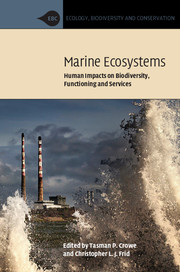11 - Human activities and ecosystem service use: impacts and trade-offs
from Part III - Synthesis and conclusions
Published online by Cambridge University Press: 05 June 2015
Summary
Introduction
Ecosystem services provided by the marine environment are fundamental to human health and well-being. Despite this, many marine systems are being degraded to an extent that may reduce their capacity to provide these ecosystem services. The ecosystem approach is a strategy for the integrated management of land, water and living resources that promotes conservation and sustainable use in an equitable way (UN Convention on Biological Diversity, 2000). Its application to marine management and spatial planning has been proposed as a means of maintaining the economic and social value of the oceans, not only in the present but for generations to come. Characterising the susceptibility of services (and combinations of services) to particular human activities based on knowledge of impacts on biodiversity and ecosystem functioning (as described in preceding chapters) is a challenge for future management of the oceans.
In this chapter, we highlight the existing, but limited knowledge of how ecosystem services may be impacted by different human activities. We discuss how impacts on one service can impact multiple services and explore how the impacts on services can vary both spatially and temporally and according to context. We focus particularly on the effects on ecosystem services of activities whose impacts on biodiversity and ecosystem functioning have already been considered in previous chapters. Some of these activities are associated with poor management of ecosystem benefits, for example, from provisioning services (aquaculture and fisheries), or with excessive input of wastes, fertilisers and contaminants into the system overburdening the waste treatment and assimilation services. Other impacts are associated with the construction of structures or use of space designed to generate benefits from environmental services such as the presence of water as a carrier for shipping, or sources of wind, wave and tidal power.
We discuss the trade-offs that are made, consciously or otherwise, between different ecosystem services, which arise from human activities to optimise or manage specific ecosystem services.
- Type
- Chapter
- Information
- Marine EcosystemsHuman Impacts on Biodiversity, Functioning and Services, pp. 335 - 376Publisher: Cambridge University PressPrint publication year: 2015

